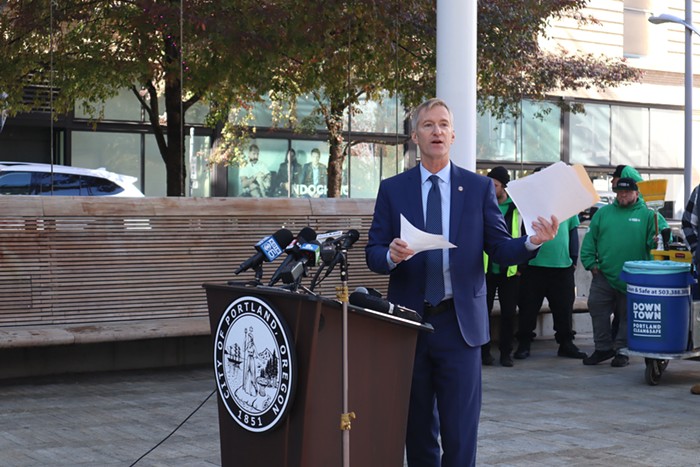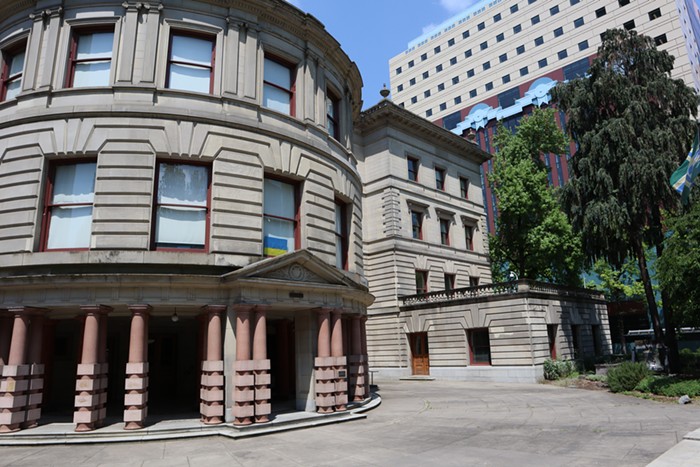
In a release this morning, the state Department of Environmental Quality announced it's hoping to pinpoint the source of hexavalent chromium (the hazardous variant of that metal) in the neighborhood around controversial factory Bullseye Glass. Despite the company ceasing to use the carcinogen in its glass melts, DEQ says, a 50-day average reading has been consistently over the target of 0.08 nanograms per cubic meter (ng/m3)—and as much as 3.5 times that concentration.
"During this period, Bullseye did not use chromium in glass production," the release says, noting that the chromium issues "demands continued scrutiny." "State investigators are visiting sites of potential sources."
While DEQ says it doesn't think there are health risks from the elevated chromium levels, it's looking at a cement supplier, rail yard, and "metal finishing business" to determine if they're emitting hexavalent chromium.
The release also notes the 50-day average for arsenic is higher than state benchmark of 0.2 ng/m3 in southeast and north Portland—even though Bullseye has stopped using arsenic until it can attach proper filters (North Portland's Uroboros Glass hasn't used the stuff in years). Those averages, between 0.6 ng/m3 and 1 ng/m3 are still far, far below eye-popping arsenic readings of 31.7 ng/m3 state officials detected near Bullseye last year, when it was melting the metal unchecked.
The averages detected are within the range that might be expected in urban environments, DEQ says—but they're still higher than the agency's owns safety levels.
Another thing? The DEQ found elevated selenium in the air. The chemical is used to make red glass, but it has application in other industries. Hit the jump for the state's full announcement.
Analysis of 50 days of air monitoring data found hexavalent chromium concentrations in the air in southeast Portland averaged above annual health-based targets. State investigators are visiting sites of potential sources to pinpoint the cause.
Though all metals are staying below Oregon 24-hour screening levels, which means there are no immediate health concerns, Oregon Department of Environmental Quality and Oregon Health Authority officials say the persistently elevated 50-day average for hexavalent chromium in southeast Portland demands continued scrutiny.
The target concentration for hexavalent chromium is 0.08 nanograms per cubic meter of air (ng/m3) when compared to an annual average, but the 50-day average has ranged between 0.086 nanograms and 0.28 nanograms across the four monitoring locations surrounding Bullseye Glass. During this period, Bullseye did not use chromium in glass production.
DEQ visits sites to find chromium source
Air results released today do not indicate the need for special precautions by neighbors, but they have prompted action on the part of state agencies to identify the sources.DEQ has reviewed information on several other potential sources in the area, including a cement supplier, the nearby rail yard, and a metal finishing business to the south. Investigators have reviewed the types of emissions that could be expected from these facilities, analyzed meteorological (wind) data to narrow potential sources and visited at least one potential source.
Bullseye has not used any form of chromium in its glass-making furnaces since February, DEQ officials say. During a recent site visit to Bullseye, a DEQ inspector reviewed the company’s list of ingredients used in a batch for glass production and chromium was not on it.
“There are other possible sources of chromium in the neighborhood where DEQ is monitoring,” said Brian Boling, DEQ laboratory program manager. DEQ will continue to evaluate these other possible sources as part of its ongoing investigation.
The 50-day average for arsenic also has stayed above targeted concentrations in both southeast and north Portland. The health-based air quality goal for that metal is 0.2 ng/m3, but 50-day averages have been between 0.6 nanograms and 1 nanogram across the five monitors from which data are available. Arsenic averages are within what is seen in urban background concentrations.
Investigators find source of selenium increase
Investigators say Bullseye is the source of a jump in levels of selenium seen during a recent week in southeast Portland. Boling said DEQ staff visited the company last week after reviewing the air monitoring data and found it increased use of the metal starting April 6. Records show it used little to no selenium between Feb. 1 and April 5.“While no samples have been above the short-term health screen levels, it was important to find out what caused the increase,” Boling said. “Bullseye increased the level of selenium used and this is reflected in the air monitoring results released today.”
Selenium is not believed to cause or increase risk of cancer, but at very high concentrations (200,000 nanograms per cubic meter of air), inhaled selenium can cause respiratory irritation, bronchitis, difficulty breathing and stomach pain.
David Farrer, Ph.D., toxicologist with the Oregon Health Authority Public Health Division, said selenium levels are higher than what has been observed so far—just above 460 nanograms, compared to 271 nanograms, the previous high from October 2015. Still, he emphasized selenium levels remain below 24-hour screening levels and do not pose an urgent or immediate health threat.
A north Portland air monitoring site does not show an increase in selenium, nor the 50-day hexavalent chromium average exceeding target concentrations. The 50-day average for arsenic was above the target concentration. Uroboros Glass, located in north Portland, has not used arsenic for many years.
Weekly air monitoring data from southeast and north Portland are reported each week by the interagency group that includes DEQ and OHA, and published at SaferAir.Oregon.gov. For information about the Cleaner Air Oregon initiative to align industrial air toxics regulations with human health, visit CleanerAir.Oregon.gov.


















